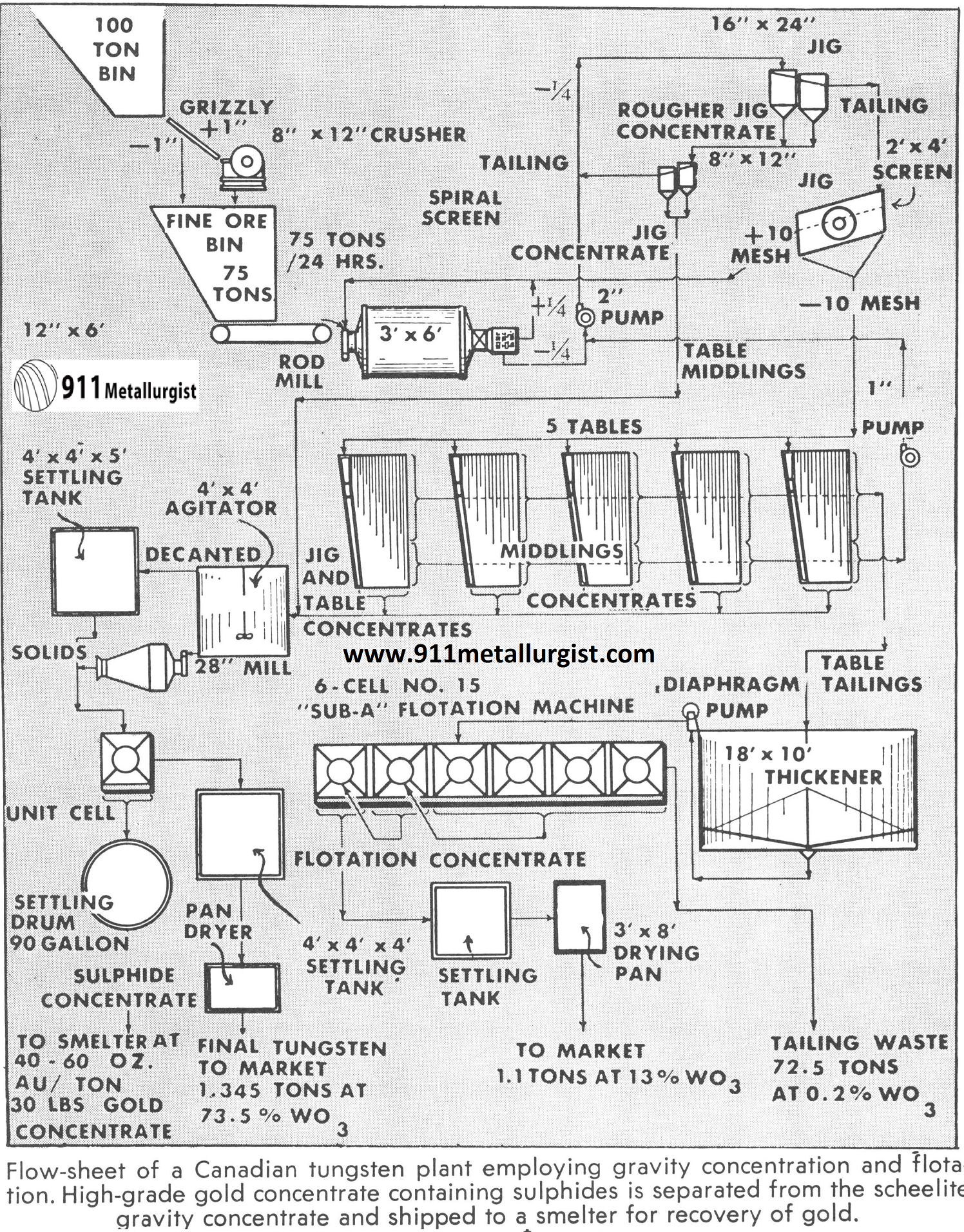Table of Contents
High price and ready market for acceptable tungsten concentrates present a very attractive incentive for the mining and processing of tungsten ores. Since all tungsten ores are very friable and slime easily, concentration must take place as soon as the mineral has been liberated by either crushing or grinding methods.
Regardless of the care taken in the selection of the flowsheet, a certain portion of the tungsten is going to be slimed, both during the mining and the milling process. In general the ability to recover the slime tungsten means the difference between success or failure of the milling installation and of the preceding mining operations.
The flowsheet shown includes gravity and flotation. It is recommended particularly for treatment of scheelite tungsten ores. It is assumed that no appreciable quantity of the scheelite is coarser than 4 mesh. The flowsheet is laid out to produce the highest possible quantity of 60% WO3 concentrates with a minimum of values being sent to the slime treatment section of the plant.
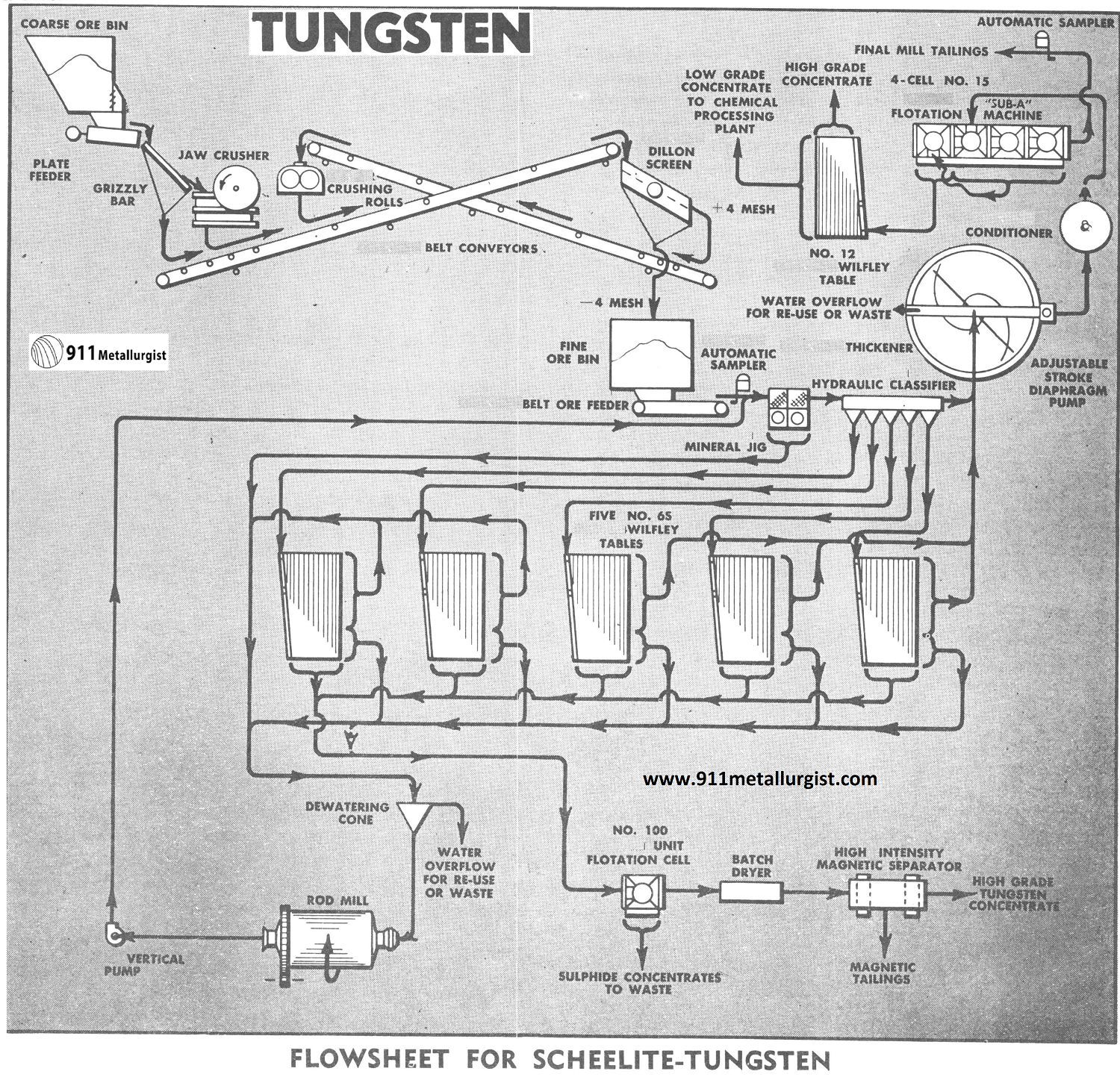
The Flowsheet for Tungsten & Scheelite Recovery
Crushing Tungsten Ore
The crushing plant is designed for operation on an 8 hour per day basis. Precautions are taken to prevent over-crushing by using a grizzly with ¾” spacing ahead of the Jaw Crusher. Also, a Vibrating Screen is used ahead of the Crushing Rolls to remove fines. The crushing rolls are operated in closed circuit with the vibrating screen to insure a-4 mesh feed to the plant.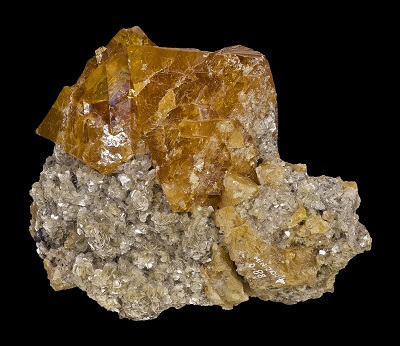
The —4 mesh product from the crushing plant passes to the 50 ton capacity fine ore storage bin.
Jigging for Tungsten in Scheelite
Crushed ore is fed at a controlled rate by means of the Adjustable Stroke Feeder to the Mineral Jig. Dilution water is added to provide a jig feed of 35% solids. The Mineral Jig, which handles the unclassified feed, is equipped with “center draw-off” arrangement for automatic discharge of coarse (+10 mesh) concentrates from the jig bed. The fine concentrates are discharged automatically from the hutch using a Dowsett Density Control Valve. Both the coarse and fine concentrates should approach 60% WO3, and free particles of tungsten as fine as 100 mesh would be expected in the concentrates.
Tungsten Tabling Circuit
Tailings from the jig flow by gravity or are pumped to the Hydraulic Classifier. Efficient tabling is dependent upon proper feed sizing into coarse, medium, fine and slime fractions. The tables each produce (a) high grade concentrates, (b) middling product, (c) tailing.
The high grade concentrate is sent to the upgrading section of the mill for removal of sulphides, iron and other impurities. At times the middling product will be of sufficient grade to be sent to this section also.
Grinding Tungsten Rock
For maximum recovery, table tailings from the coarse, medium and fine tabling operations are sent to the dewatering cone and thence to the Rod Mill equipped with peripheral discharge.
The rod mill discharge then enters the circuit again as feed to the Mineral Jig where the newly liberated particles are concentrated. In this manner sliming and overgrinding are kept to a minimum.
https://www.911metallurgist.com/tungsten-ore-extraction-processing-flowsheet
Tungsten Flotation
The tailings from the slime tables and the hydraulic classifier slime overflow pulp must be thickened to approximately 20 to 25% solids for subsequent flotation. The underflow from the thickener is metered by a Adjustable Stroke Diaphragm Pump to the Conditioner where reagents are added. Common reagents and quantities per ton head feed used in the flotation of scheelite are as follows: Promoter—oleic acid about 1 pound; Dispersant—sodium silicate about one pound; pH Control—two to three pounds; Frother—not usually required with oleic acid.
The “Sub-A” Flotation Machine produces a rougher concentrate which is usually recleaned once to produce a concentrate which will assay approximately 13 to 15% WO3. The flotation concentrate is tabled to remove a high grade concentrate. The table tailings can be shipped to an acid plant for production of synthetic scheelite.
Five No. 6-S Wilfley Tables like the one below are fed by a Hydraulic Classifier to produce tungsten concentrate with sulphides, which are subsequently removed in a “Sub-A” Unit Flotation Cell.
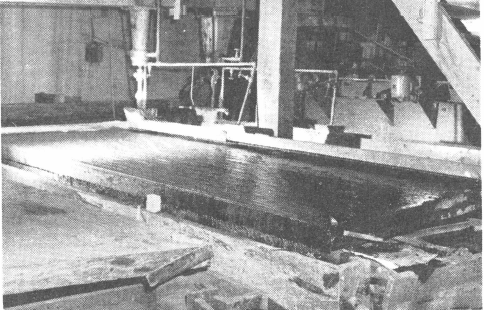
Circuit for Cleaning Tungsten and Upgrading Scheelite
The Mineral Jig and Wilfley Table concentrates are sent to the upgrading section for removal of sulphides, garnet, magnetic iron, and other impurities. The sulphides are removed by “Sub-A” Flotation. This is usually a batch process using a Unit Cell. Concentrates are charged at 30% solids and after approximately 15 minutes all the sulphides have been removed.
The concentrates are then dried on a batch dryer and fed to a high intensity dry magnetic separator for removal of magnetic iron and garnet.
Sometimes, the concentrates contain excess phosphorous which can be removed by leaching with sulphuric acid. Calcite can be removed with a hydrochloric acid leach. Other impurities can be eliminated in like manner to produce concentrates which meet government or other market specifications.
Details of how the Selective Mineral Jig, with “center draw-off,” operates to separate coarse and fine concentrates
approaching 60% WO3. Coarse particles are sent to a Rod Mill for further reduction.
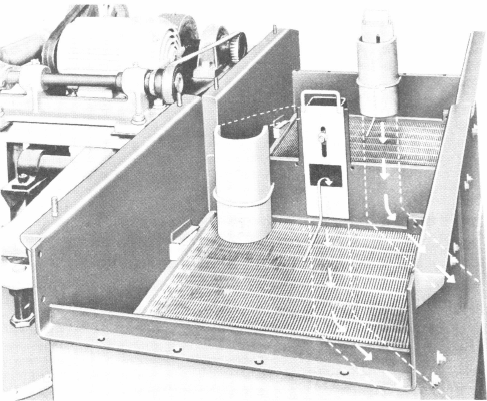
Scheelite Market Specifications
Following are market specifications as to grade and impurities for scheelite concentrates:
- WO3, minimum………………………………………………………………60.0 per cent
- Cu, maximum………………………………………………………………….0.05 per cent
- Pb, maximum………………………………………………………………….0.10 per cent
- P, maximum……………………………………………………………………0.05 per cent
- As, maximum…………………………………………………………………..0.10 per cent
- Bi, maximum……………………………………………………………………0.25 per cent
- Mo, maximum………………………………………………………………….0.40 per cent
- Sn, maximum…………………………………………………………………..0.10 per cent
- S, maximum…………………………………………………………………….0.50 per cent
- Sb, maximum……………………………………………………………………0.10 per cent
- Mn, maximum………………………………………………………………….1.00 per cent
- Zn, maximum…………………………………………………………………..0.10 per cent
Production Problems
The percentage of impurity in the original concentrate is generally so high that re-treatment for their removal, generally by re-flotation and acid treatment, is necessary.
A marketable grade of scheelite is rarely, if ever, made by flotation, but an increased recovery is realized by its use and the product can be treated by soda ash solution in an autoclave. In this process the scheelite is dissolved and, by addition of lime, calcium tungsten, or “synthetic scheelite,” is precipitated.
Reagent Combinations
Scheelite is quite readily floatable with fatty acids in an alkaline circuit with soda ash and sodium silicate. Other non-metallic minerals such as calcite and fluorspar are often present in the ore, so a high- grade scheelite concentrate is difficult to produce by flotation. Sulphides, if present, must be floated ahead of the scheelite.
Conclusion
This paper has described the principal problems met in a practical way in beneficiating non-metallic industrial minerals. Flow-sheets have been presented showing how some typical problems have been solved. Space has not permitted a thorough discussion of the use of specific reagents. However, much information on this subject is available from other technical articles and the bibliographies that may be found in them.
As an aid to further study of the various problems, the following references are suggested:
- U. S. Bureau of Mines Report of Investigations 3397, Flotation and Agglomerate Concentration of Non-Metallic Minerals, by Oliver C. Ralston. This report covers flotation of non-metallic minerals from the investigation standpoint and contains an excellent bibliography of the work of others.
Source: This article is a reproduction of an excerpt of “In the Public Domain” documents held in 911Metallurgy Corp’s private library.


